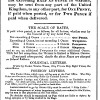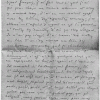
Jason Camlot, “The First Phonogramic Poem: Conceptions of Genre and Media Format, Circa 1888”
By 1888, the technology of the phonograph, and the medium of the phonograph cylinder, were established as market-ready. What was the imagined potential of this media technology in relation to known modes of communication and expression? This article recounts how “The Phonogram” or phonographic letter was prototyped from 1887 to 1892 through the efforts of Thomas Alva Edison and his London agent George Gouraud. Edison’s prototyping work and Gouraud’s efforts in developing recordings, scripts for phonogramic speeches, and formats for typographical transcription of the cylinder recordings represent a rich case study for documenting the nature and significance of their efforts to consolidate the medium and define the generic parameters of the phonogram (a speech recording) as a distinct form of global communication. By theorizing the relationship between late-Victorian concepts of medium, format and genre, respectively, and by interpreting the “first phonogramic poem” (16 June 1888) as an articulation of the meaning of sound recording at the historical moment that it arrived as a viable media technology, this article helps explain how sound recording technologies were imagined in relation to specific genres of communication. Drawing upon periodical literature, and documentation available through the Thomas Edison Papers archive—including phonogramic transcripts and speeches, marketing and foreign business strategies, patent applications, and packaging and design documents—this article explains, in particular, the generic and rhetorical protocols that informed the attempt to establish the phonogram as a new medium of intimate communication and international correspondence.

Susan Donovan, “How the Post Office and Postal Products Shaped Mid-Nineteenth-Century Letter-Writing”
In an age of electronic communication it is easy to forget the vital role that letter-writing played in people’s everyday lives in the nineteenth century. Critical attention has tended to focus more on the communicative function of letters than on what is often considered as the more mundane material aspects of letter exchange such as the postal service or the type of stationery used. This article explores the impact of mid-century postal reforms, improved transportation and new postal products on the letter-writing practice and epistolary relationships of Arthur Hugh Clough. My reasons for making Clough the central case study of this piece are two-fold: firstly, because of the large body of correspondence that exists between him and his American literary friends over the period of the mid-nineteenth century (c.1847-1861); and secondly, Clough’s interest in, and innovative use of the epistolary form in his poetry. The article underlines the significance of the postal revolution for Clough’s life and work, which can hardly be overstated. The greatly improved transatlantic mail service enabled him to keep in regular contact with his closest friends and publishers and to send them, over a period of several years, all the revisions and additions to his most important work: Amours de Voyage, published for the first time in the US in 1858; his acclaimed translation of Plutarch’s Lives (1859) and the definitive edition of his collected poems, published posthumously in the USA in 1862. The article also highlights instances where material circumstances—the curtailment of the transatlantic mail service, or lost and delayed letters—had an adverse effect on Clough’s correspondence and on his publishing projects. On this point, I draw parallels with Clough’s epistolary poetry—most notably Amours de Voyage—whose form and plot clearly illustrate the importance he attached to the medium of correspondence. The article also demonstrates Clough’s awareness of the role played by postal products in the construction of an “epistolary self”—another aspect of materiality that is reflected in his creative work. Clough is the central figure of this study but I have widened the focus in some places to include some apposite quotations from the Brownings’ correspondence and Carlyle’s letters to demonstrate the far-reaching effects of the material aspects of letter-writing on the correspondence culture of the time.
![Figure 2: First Scottish colony for New Zealand. [Reprinted] Copyright People’s Palace Museum, Glasgow Green [ca 1981]. Alexander Turnbull Library, Wellington, New Zealand. Ref: Eph-C-IMMIGRATION-1839-01. Used with permission. http://natlib.govt.nz/records/22730739.](https://branchcollective.org/wp-content/uploads/2017/04/2-First-Scottish-Colony-for-New-Zealand-100x100.jpg)
Philip Steer, “On Systematic Colonization and the Culture of Settler Colonialism: Edward Gibbon Wakefield’s A Letter from Sydney (1829)”
In 1829, Edward Gibbon Wakefield published his first statement of a “systematic” theory of settler colonization, A Letter from Sydney: The Principal Town of Australasia. Wakefield offered a novel economic theory of the relationship between population density and successful colonization, hinging on the establishment of a minimum or “sufficient” price on colonial land, and he spent the next few decades at the forefront of efforts to promulgate and profit from it. The theory of systematic colonization was first put into practice in 1836 in the new colony of South Australia, and then more extensively in New Zealand in 1839; in both cases, speculative mania in Britain precipitated the invasion of thousands of settlers, even though the settlements were as yet unmapped. Wakefield’s theories were also at the center of a new imperial imaginary that emerged in Britain by the 1850s, which established Australia and New Zealand as pastoral locations capable of restoring damaged British subjects. In spurring the vast expansion of migration to Australia and New Zealand, contributing to the genocide and dispossession of indigenous populations, and accelerating the destruction of local ecosystems, systematic colonization constitutes one of the most powerful and destructive examples of the ability of Victorian representations to permanently reshape the globe.

Kate Lawson, “Personal Privacy, Letter Mail, and the Post Office Espionage Scandal, 1844”
The Post Office espionage scandal of 1844 began with the revelation that the British government, at the behest of the Austrians, had opened letters sent to the Italian nationalist Giuseppe Mazzini, then resident in London. This essay examines how letters themselves were represented in discussions of the scandal in parliament, the press, and other sources in June of that year. Two key attributes of letters were repeatedly identified, that letters were private and that letters contained secrets. The essay argues that these two claims about letters helped shape emerging definitions of privacy in personal communications and that the scandal raised questions about reasonable expectations of privacy that are at once Victorian and distinctly contemporary.

Marjorie Stone, “Joseph Mazzini, English Writers, and the Post Office Espionage Scandal: Politics, Privacy, and Twenty-First Century Parallels”
In 1844, an English radical MP affiliated with the Chartist movement petitioned the House of Commons, charging that Sir James Graham, Secretary of State for the Home Office, had secretly authorized the opening of the letters of exiled Italian nationalist and resident of London, Joseph Mazzini, spying upon their contents. The ensuing Post Office espionage scandal is a pivotal event in British and European history, represented—like Mazzini himself—from conflicting perspectives and shaping a host of subsequent developments. It provoked “anti-Graham” envelopes and parodies in Punch, intensified British sympathy for the Italian liberation and unification movement for which Mazzini was the principal theorist, and influenced British policy towards the 1847-49 revolutions in Italian states struggling for independence from Austrian overlords and autocratic Bourbon kings. The scandal and the networks it forged also shaped British party politics, Chartist international alliances, and emerging conceptions of rights to privacy and limits on state surveillance. Mazzini, revered as an apostle by many, was viewed as a dangerous subversive by many others, including the Pope and Prince Klemens von Metternich, Foreign Secretary to the Austrian Empire, later one of Henry Kissinger’s diplomatic models. As the scandal unfolded, evidence indicated that Graham and the Foreign Secretary Lord Aberdeen shared information from Mazzini’s letters with the Austrians, linking British espionage to the execution of the Bandiera brothers, Italian revolutionaries, in Naples in July 1844. This essay surveys diverse responses to Mazzini and the literary and cultural as well as the political repercussions of the 1844 scandal. Prominent English writers, notably Thomas Carlyle, came to Mazzini’s defence, especially indignant over violations of privacy, while others—including Robert Browning, Elizabeth Barrett Browning, George Meredith, Algernon Charles Swinburne, and George Eliot—went on to write works influenced by the charismatic, controversial Italian nationalist. An epilogue notes some of the 1844 event’s parallels with current controversies over communications hacking (WikiLeaks, the News of the World phone hacking) and appropriate limits on state secrecy and surveillance in the wake of 9/11, 7/7, anti-terrorism legislation, and the “rendition” of information and/or persons such as Canadian-Syrian Maher Arar to oppressive regimes by democratic countries.
